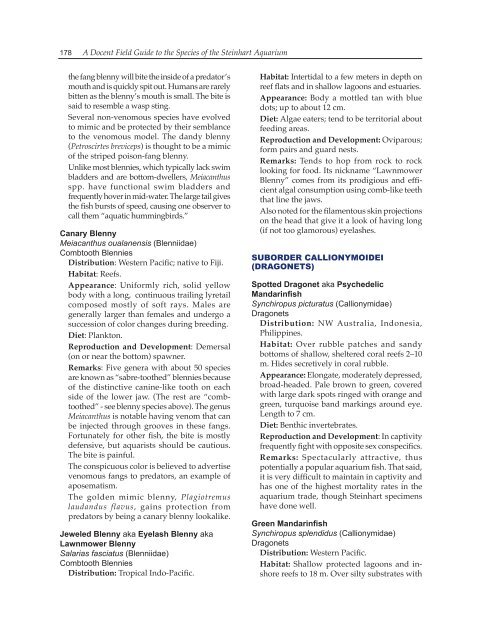THE STEINHART AQUARIUM - Gulf of Guinea Science ...
THE STEINHART AQUARIUM - Gulf of Guinea Science ...
THE STEINHART AQUARIUM - Gulf of Guinea Science ...
You also want an ePaper? Increase the reach of your titles
YUMPU automatically turns print PDFs into web optimized ePapers that Google loves.
178 A Docent Field Guide to the Species <strong>of</strong> the Steinhart Aquarium<br />
the fang blenny will bite the inside <strong>of</strong> a predator’s<br />
mouth and is quickly spit out. Humans are rarely<br />
bitten as the blenny’s mouth is small. The bite is<br />
said to resemble a wasp sting.<br />
Several non-venomous species have evolved<br />
to mimic and be protected by their semblance<br />
to the venomous model. The dandy blenny<br />
(Petroscirtes breviceps) is thought to be a mimic<br />
<strong>of</strong> the striped poison-fang blenny.<br />
Unlike most blennies, which typically lack swim<br />
bladders and are bottom-dwellers, Meiacanthus<br />
spp. have functional swim bladders and<br />
frequently hover in mid-water. The large tail gives<br />
the fish bursts <strong>of</strong> speed, causing one observer to<br />
call them “aquatic hummingbirds.”<br />
Canary Blenny<br />
Meiacanthus oualanensis (Blenniidae)<br />
Combtooth Blennies<br />
Distribution: Western Pacific; native to Fiji.<br />
Habitat: Reefs.<br />
Appearance: Uniformly rich, solid yellow<br />
body with a long, continuous trailing lyretail<br />
composed mostly <strong>of</strong> s<strong>of</strong>t rays. Males are<br />
generally larger than females and undergo a<br />
succession <strong>of</strong> color changes during breeding.<br />
Diet: Plankton.<br />
Reproduction and Development: Demersal<br />
(on or near the bottom) spawner.<br />
Remarks: Five genera with about 50 species<br />
are known as “sabre-toothed” blennies because<br />
<strong>of</strong> the distinctive canine-like tooth on each<br />
side <strong>of</strong> the lower jaw. (The rest are “combtoothed”<br />
- see blenny species above). The genus<br />
Meiacanthus is notable having venom that can<br />
be injected through grooves in these fangs.<br />
Fortunately for other fish, the bite is mostly<br />
defensive, but aquarists should be cautious.<br />
The bite is painful.<br />
The conspicuous color is believed to advertise<br />
venomous fangs to predators, an example <strong>of</strong><br />
aposematism.<br />
The golden mimic blenny, Plagiotremus<br />
laudandus flavus, gains protection from<br />
predators by being a canary blenny lookalike.<br />
Jeweled Blenny aka Eyelash Blenny aka<br />
Lawnmower Blenny<br />
Salarias fasciatus (Blenniidae)<br />
Combtooth Blennies<br />
Distribution: Tropical Indo-Pacific.<br />
Habitat: Intertidal to a few meters in depth on<br />
reef flats and in shallow lagoons and estuaries.<br />
Appearance: Body a mottled tan with blue<br />
dots; up to about 12 cm.<br />
Diet: Algae eaters; tend to be territorial about<br />
feeding areas.<br />
Reproduction and Development: Oviparous;<br />
form pairs and guard nests.<br />
Remarks: Tends to hop from rock to rock<br />
looking for food. Its nickname “Lawnmower<br />
Blenny” comes from its prodigious and efficient<br />
algal consumption using comb-like teeth<br />
that line the jaws.<br />
Also noted for the filamentous skin projections<br />
on the head that give it a look <strong>of</strong> having long<br />
(if not too glamorous) eyelashes.<br />
SUBORDER CALLIONYMOIDEI<br />
(DRAGONETS)<br />
Spotted Dragonet aka Psychedelic<br />
Mandarinfish<br />
Synchiropus picturatus (Callionymidae)<br />
Dragonets<br />
Distribution: NW Australia, Indonesia,<br />
Philippines.<br />
Habitat: Over rubble patches and sandy<br />
bottoms <strong>of</strong> shallow, sheltered coral reefs 2–10<br />
m. Hides secretively in coral rubble.<br />
Appearance: Elongate, moderately depressed,<br />
broad-headed. Pale brown to green, covered<br />
with large dark spots ringed with orange and<br />
green, turquoise band markings around eye.<br />
Length to 7 cm.<br />
Diet: Benthic invertebrates.<br />
Reproduction and Development: In captivity<br />
frequently fight with opposite sex conspecifics.<br />
Remarks: Spectacularly attractive, thus<br />
potentially a popular aquarium fish. That said,<br />
it is very difficult to maintain in captivity and<br />
has one <strong>of</strong> the highest mortality rates in the<br />
aquarium trade, though Steinhart specimens<br />
have done well.<br />
Green Mandarinfish<br />
Synchiropus splendidus (Callionymidae)<br />
Dragonets<br />
Distribution: Western Pacific.<br />
Habitat: Shallow protected lagoons and inshore<br />
reefs to 18 m. Over silty substrates with


